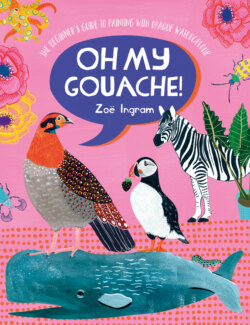Читать книгу Oh My Gouache! - Zoë Ingram - Страница 9
На сайте Литреса книга снята с продажи.
ОглавлениеBrushes and Palettes
Choosing brushes, paper and palettes can be a bit overwhelming and confusing as a beginner. If you’re buying your essential toolkit in an art store, remember that you can ask for help if you’re unsure. The staff are generally very knowledgeable and can help you to find the right tools for the job. The more you practise, the more familiar you’ll become with the materials that you work with, and you’ll soon have the confidence to seek out just what you need without assistance.
Here are my top tips to get you started.
Brushes
I have a million brushes, old and new, big and small, square and round, but I tend to gravitate towards the same faithful brushes over and over. You’ll find, through practice, which types and makes of brushes you prefer to work with and that suit your painting style. I like a mixture of sizes because I sometimes paint in a quick, expressive painterly fashion, yet I also paint quite tight images with a lot of detail and flat colour, so having tiny brushes is a necessity. I almost always go for synthetic brushes that are intended for watercolour use.
There are various types of brush on the market, sometimes too many to choose from: round, rigger, one stroke, angled, filbert, long handle, short handle, mops, wash brush and fan. To begin with, I recommend a set of round brushes in a variety of sizes, as these can cope with washes, solid colour, lines and detail.
BRUSHES ARE USUALLY SIZED FROM 0000 (SMALLEST) TO 24 (LARGEST). SIZES 0, 2, 4, 6, 8 ARE A GOOD STARTING POINT, AND IF YOU WANT TO ADD VERY FINE DETAILS, SOMETHING SMALLER LIKE A 00 OR EVEN 000 IS HANDY TO HAVE IN YOUR KIT.
Palettes
I’ve tried a lot of different palettes in the past and my favourite by far is an old white ceramic plate. The surface is smooth, which makes it easy to mix the paint, and, because it’s white and doesn’t discolour or stain, it’s easier to see the colours that I’m mixing. You could use an old white plate that you were going to throw out, or hunt for one in a thrift shop. Disposable paper palettes are a great option for using on the go or if you really don’t have the energy to clean up after a day of painting; you simply remove the top sheet and throw it away when you need a fresh palette.
Plastic palettes are an option, too, although I find that they’re harder to clean and tend to stain, and I like my palette to be fresh and clean for the next load of paint. Some palettes have compartments so that your paint doesn’t run into the other colours, but I prefer to have a simple flat palette. You can buy palettes that have a lid to cover and seal in unused paint, which is a great idea, but you can achieve the same result by wrapping plastic food wrap over your palette to keep your paint fresh and to stop it from drying out.
